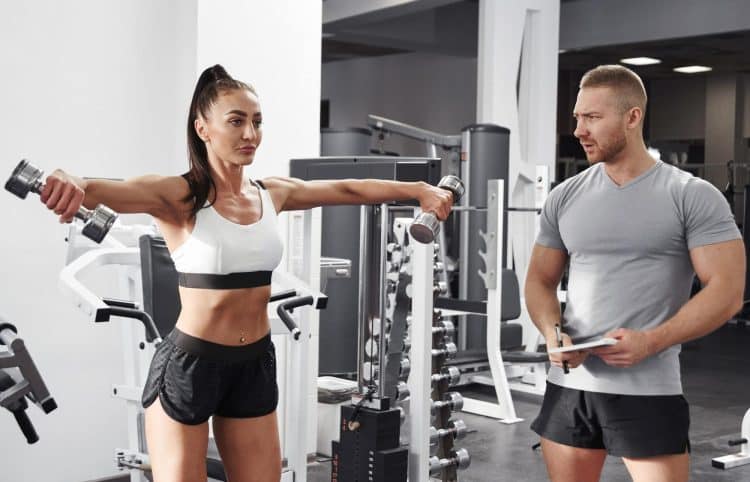Few things upset me more than seeing otherwise enthusiastic gym-goers wasting their time on ineffective exercises and workouts. After all, burning fat, building muscle, and getting in shape requires a big investment of time, energy, and effort. Spending those valuable resources while earning less than maximal returns is a crime against fitness!
Most people don’t waste their time and energy on purpose and are generally unaware that their workouts aren’t as effective as they should be. Instead, they blame their program, diet, genetics, or supplement choices.
However, in many cases, the problem isn’t the workout or the wrong pills and potions. Instead, it’s the long-held belief in the many myths like “no pain, no gain” that are blocking those gains.
The fitness industry is full of diet and exercise myths, many of which are so widely believed that they are woven into the very fabric of working out.
In this article, we debunk some of the most popular fitness myths so you can take the brakes off your training and start seeing the results you deserve.
13 Popular Fitness Myths Debunked
Myths are widely held but false beliefs or ideas that are perpetuated through tradition, culture, or social acceptance. For example, one commonly-held myth is that lightning never strikes the same place twice. However, in reality, lightning can and does strike the same location multiple times. For instance, the Empire State Building in New York City is struck by lightning about 20 to 25 times a year.
Level Up Your Fitness: Join our 💪 strong community in Fitness Volt Newsletter. Get daily inspiration, expert-backed workouts, nutrition tips, the latest in strength sports, and the support you need to reach your goals. Subscribe for free!
Myths can exist in various domains, including history, science, and everyday life, and are especially prevalent in fitness training.
Here are 13 of the most popular fitness myths, explored and debunked just for you!
1. No Pain, No Gain
No pain, no gain is probably the most widely believed myth in fitness. There is a strongly held belief that the more you suffer, the better your results will be. This is evident from the vast number of extreme workouts and super-strict diets out there. These programs and plans seem designed to make you miserable by making you uncomfortable.
Images of grimacing bodybuilders and fitness influencers training themselves into rhabdomyolysis do nothing to counter this myth. Pain is compulsory if you want to build muscle and get fit, right?
The reality is that there is a huge difference between pain and exercise and diet-related discomfort. In fact, pain is usually an indicator that something is wrong and is your body’s way of telling you to stop.
Training through pain doesn’t mean you are tough, and nor does it mean you’ll get better results. Pain could be an indicator that what you are doing is dangerous or is the start of an injury. In addition, post-training muscle soreness, which is another common source of fitness-related pain, is not a reliable indicator of an effective workout. It’s just a sign that you have pushed your body harder than it’s used to.
None of this means that you don’t have to train hard to build muscle, get fit, etc., and that will cause some discomfort. However, there is a gulf of difference between training discomfort and genuine pain.
Summary: It’s time to stop associating pain with gains as, in most cases, pain is actually a warning sign and best avoided. Although, it’s fair to say that “no moderate discomfort, no gains” is much less catchy! So, train hard, and don’t be afraid to push yourself, but don’t seek out or ignore pain. Pain is a warning and not a reward.
2. Abs Exercises Will Give You a Flat Stomach
It’s a commonly held belief that doing lots of abs exercises, usually for high reps, will flatten your stomach and melt away abdominal fat. There are entire workouts and group exercise programs designed around this notion.
Sadly, you’ll need more than hundreds of crunches to flatten your stomach, as the idea of spot reduction is a myth.
The idea of spot reduction makes sense, which is why it’s such a pervasive myth. The belief is that doing lots of abs exercises and the intense burning sensation they cause dissolves fat from the area you are working. It’s unclear where this myth originated, but early ’80s fitness guru Jane Fonda probably didn’t help matters with her “feel the burn” mantra.
Your body stores fat according to its needs and your genetics. It burns fat in much the same way. Your choice of exercise does not determine from where fat is used; fat loss occurs uniformly across the body.
If you want a slimmer stomach, direct abs training can help, but your general diet and exercise program are much more important. So, train your abs, but only as part of a well-rounded workout routine and diet plan.
Summary: Doing endless sets of crunches, sit-ups, planks, etc., won’t melt fat from your abdomen and give you a flatter stomach. Your overall workout plan and diet are what will help you shed that unwanted belly fat.
3. Cardio is the Best Way to Lose Weight
Go to any gym, and you’ll invariably see people trying to run, cycle, row, or step themselves slimmer. They spend hour after hour sweating over cardio machines in an effort to burn fat and lose weight.
Come back in a year, and those people will probably still be there and won’t have lost much, if any, weight.
But cardio burns fat, so more cardio means more fat loss, right?
While cardio does indeed predominantly burn fat, it does so in relatively small amounts. A pound of fat contains about 3,500 calories, which is enough to fuel roughly 35 miles of running. Unfortunately, it’s very easy to wipe out this caloric expenditure with a few unplanned snacks or cheat meals.
And as for the so-called fat-burning zone? This is also a sort-of myth.
The idea of the fat-burning zone is that doing cardio at about 60-70% of your maximum heart rate predominately uses fat for fuel. However, while this is true, the actual amount of fat used at this low level of intensity is pretty low.
Training harder uses more carbohydrates for fuel, but your total energy expenditure will be considerably higher. It’s like this – what would you rather have: 90% of a million dollars or 1% of a billion dollars? To save you doing the math, 1% of a billion is a much bigger pile of money.
Doing lots of cardio does not guarantee fat loss. There are several additional factors you also need to consider, including diet and nutrition, strength training, and your general lifestyle. Cardio alone is not the best way to strip your body of fat.
Summary: Cardio burns fat, but not as much as many people believe. Alone, it’s not enough to guarantee fat and weight loss. Instead, cardio should be part of a balanced weight management plan that also includes strength training and a sustainable diet.
4. Eating Fat Makes You Fat
Fat has long been vilified and blamed for a wide range of medical maladies, including heart disease and even cancer. However, the most common criticism of dietary fat is that it makes you fat. This myth suggests that any fat you eat is quickly stored as body fat. A moment on the lips and a lifetime on the hips, as the popular weight loss clubs like to say!
This myth does make a certain amount of sense, given that dietary fats contain nine calories per gram compared to protein and carbohydrates, both of which have four calories per gram.
However, the idea that eating fat makes you fat is a vast overcomplication, as the total number of calories you eat compared to the number of calories you expend is what actually determines fat loss and fat gain (1).
Ultimately, a calorie excess from any source will lead to fat gain. Consume more carbs or protein than your body needs, and it will convert the excess calories to fat and store it for later use.
So, eating too much fat can make you fat, but that’s true for protein and carbs, too. Total caloric intake matters more than where those calories come from.
Contrary to popular belief, healthy fats are essential for overall well-being and can actually assist weight loss. That’s because they delay gastric emptying, helping to keep you feeling fuller for longer. Fats also aid in regulating your blood glucose, leading to more stable energy levels.
Summary: Fat is not the health and weight loss enemy that many people believe. In fact, in moderate amounts, it could actually help you lose weight. The same cannot be said for refined carbs and sugar, which are the true nutritional villains.
5. Lifting Weights Will Make You Bulky
A lot of women and some men avoid lifting weights because they don’t want to bulk up and become overly muscular. It’s as though they believe a few strength workouts will leave them with the physique of a bodybuilder.
If only building muscles was that easy!
Building appreciable amounts of muscle takes a huge amount of energy, time, and commitment. Not only do you have to train hard, you also need to manage your diet and lifestyle. Even then, muscle hypertrophy or growth is a slow and laborious process. It doesn’t happen quickly or easily, and even the most gifted bodybuilders had to fight for every pound of muscle they built.
The idea that lifting weights makes you bulky is ludicrous, and there are thousands of frustrated bodybuilders who only wish that gaining muscle was easier.
So, while you can lift weights to build bigger muscles, this doesn’t have to be how strength training affects your body. You can also lift weights to improve muscle tone and endurance, power and athleticism, joint mobility and health, and even weight loss and fat burning. Weightlifting is a tool, and the results you will experience depend on how you wield it.
In fact, given the far-reaching benefits of strength training, everyone should lift weights if they want to be fit, strong, and healthy and stay that way for as long as possible.
Summary: Strength training will only “bulk you up” if you want it to. Bigger muscles don’t happen by accident, and increasing muscle size takes a very particular type of training and diet. Ultimately, how strength training affects your body is entirely up to you, and significant muscle gain is not compulsory.
6. More Sweat Equals More Calories Burned
A lot of exercisers rate their workouts by how much they sweat. I’ve had personal training clients who, when asked what they wanted to get from their session, replied, “A good sweat.” Group exercise instructors at one of the studios I used to work at considered it a badge of honor if they could get their class to sweat so much that the windows steamed up.
People tend to associate sweating with fat loss. This makes a certain amount of sense, given that sweating often leads to weight loss. However, this is not necessarily a reliable indicator of a good workout.
We sweat to regulate our body temperature and avoid overheating. As you exercise, your metabolism increases, and that raises your core temperature. Your body releases sweat, which evaporates from your skin, taking some excess heat with it. The hotter you get, the more you sweat. However, some people sweat more or less than others, and your environment can also affect how much you perspire.
Sweat is water, and water is heavy. One liter of water weighs one kilo, or, in America, a pint of water weighs just over one pound. So, if you have a sweaty workout, you could lose several pounds of water weight.
However, as soon as you rehydrate, your body will replace that lost water, and your weight will return to normal. Weight loss through sweating is temporary at best.
It’s also worth noting that losing even a small percentage of your overall body weight in water can have a detrimental effect on your workout performance. You may need to slow down or even end your workout early if you become too dehydrated. Needless to say, this will not enhance your calorie-burning and fat-loss efforts.
Summary: Sweating is not an accurate indicator of calorie expenditure; it’s merely the body’s way of regulating temperature. Any weight lost through sweating will be regained when you rehydrate. Being very dehydrated can actually make workouts less effective, undermining your fat-loss efforts.
Level Up Your Fitness: Join our 💪 strong community in Fitness Volt Newsletter. Get daily inspiration, expert-backed workouts, nutrition tips, the latest in strength sports, and the support you need to reach your goals. Subscribe for free!
7. More Protein Equals More Muscle
Most exercisers are well aware of the benefits of consuming adequate protein. This essential nutrient plays a critical role in muscle repair and growth, helps preserve muscle mass during low-calorie diets, is filling, and can help regulate your blood glucose levels. This all means that protein has an almost superfood status, and many people follow high-protein diets and use protein supplements.
However, some bodybuilders believe that if some protein is good, more must be better, and they pound down protein shakes by the gallon in the belief that more protein means more muscle growth.
Sadly, there is a point of diminishing returns, and your body can only use so much protein. Consume too much, and it’ll be converted to glucose and used as energy or turned into and stored as fat. Some just end up going down the toilet.
Studies indicate that there is very little benefit to consuming more than 2.2 grams of protein per kilogram of body weight, and most people can build muscle on 1.7 to 2.0 grams or less (2). It’s worth remembering that, compared to carbs, protein foods are pretty expensive, so consuming more than you need is a waste of money.
So, get enough protein, but don’t think that consuming more means faster muscle growth. You may not even need protein shakes to get enough protein to build muscle. Some studies even go so far as to suggest that consuming too much protein for prolonged periods (i.e., several years) could be bad for your health (3).
Summary: While protein is crucial for muscle repair and growth, consuming more than you need won’t lead to better gains. Monitor your protein intake to ensure you’re getting enough, but don’t consume more than you need, or you may just end up gaining fat.
8. Resistance Machines are Safer Than Free Weights
Strength training is generally considered to be a very safe activity. Rates of injury are very low, especially compared to most recreational sports (4).
However, there is a belief that free weights (barbells, dumbbells, kettlebells) are more dangerous than resistance machines (leg press, lat pulldown, cable crossovers). In fact, some people believe that free weight exercises are best avoided by beginners, and some gyms go so far as only to have resistance machines.
Resistance machines guide your movements, and some provide back support. This certainly gives an illusion of increased safety. However, machines also lock you into a movement pattern that may not match your biomechanics, and most are made to accommodate average-sized users. Taller or shorter users may not fit the machine properly, increasing biomechanical stress. However, training to failure with resistance machines is usually a safe undertaking, as there is no weight to fall on you if you cannot complete a rep.
In contrast, free weight exercises generally require more balance and coordination than their resistance machine counterparts, and a failed rep can cause serious injury. However, it’s much easier to modify the movement to match your biomechanical needs. This usually means less joint stress and a more comfortable workout.
It’s a myth that free weights are dangerous and resistance machines are safe, as the opposite can also be said depending on the exerciser and their circumstances. So, don’t feel that, just because you work out on machines, your training is automatically safe, as that is definitely not the case.
Summary: Many people believe machines are safer because they guide your movements. However, free weights offer a more natural range of motion and engage stabilizing muscles, which can be beneficial for functional fitness and injury prevention.
9. Stretching Before Exercise Prevents Injury
A good workout starts with a thorough warm-up. Warming up prepares your muscles and joints for what you are about to do and can enhance your performance by optimizing your physical and mental state.
For many people, this means spending several minutes stretching the muscles they’re about to use. This, they believe, helps lower their risk of injury. Stretch your hamstrings and avoid hammie pulls, right?
Unfortunately, this is another myth, and stretching before exercise may actually make your workout less effective while doing nothing for your risk of injury.
Studies suggest that static (or stationary) stretching before exercise has no impact on injury risk (5). In fact, common sense suggests that static stretching could increase injury risk by lowering circulation and tissue temperature and may reduce force production potential, leading to less effective workouts.
In contrast, moving or dynamic flexibility and mobility exercises are viewed as safer and more effective for lowering injury risk and improving performance. They also maintain tissue temperature and often replicate the movements you’re about to do in training, providing a useful rehearsal opportunity.
Summary: Warm-ups are critical for safer workouts, but there is a right way and a wrong way to do it. Forget about static stretches and embrace dynamic stretching. While they may not decrease your risk of injury, they certainly won’t increase it like static stretching can, and your workouts will be more effective.
10. Diet Foods Lead to Weight Loss
If you want to lose weight and get lean, you’ll need to change your diet. Invariably, this means eating smaller portions and consuming more lower-calorie foods, such as lean proteins, whole grains, fruits, and vegetables.
However, you may also be tempted to replace your favorite high-calorie treats with so-called diet foods, such as low-sugar desserts, fat-free ice cream, and weight-loss-friendly cookies.
Unfortunately, rather than being good for weight loss, diet foods like sugar-free cookies can actually cause weight gain rather than the intended weight loss. This is because of something called the health halo.
The health halo describes how some people overeat a particular food because they believe it’s good for them. For example, instead of eating one regular cookie, you might eat three so-called diet cookies. So, rather than consuming fewer calories, you end up ingesting more.
The health halo does not just apply to diet foods but to healthy foods in general. It’s easy to think that a food labeled as healthy can be eaten in large amounts without hindering weight loss or leading to weight gain. Sadly, this is not the case.
Summary: Diet foods do not automatically lead to weight loss. In fact, because of something called the health halo, they can actually lead to overeating and weight gain. Portion control is a far better way to lower your calorie intake, and eating diet versions of the foods that caused your weight gain is not an effective weight-loss solution.
11. You Can Out-Exercise a Bad Diet
It’s a common misconception that you can eat whatever you want if you exercise. The idea is that you can “burn off” the extra calories from that double cheeseburger or slice of chocolate cake with an intense workout. This myth is not only misleading but also dangerous for those who are serious about achieving optimal health and fitness.
The average person burns around 300 to 400 calories in an hour-long moderate-intensity workout. However, a junk food meal could contain as many as 1,000 calories or more. It’s a simple matter of math; you can’t out-exercise a caloric surplus, especially one that’s substantial.
Moreover, an unhealthy diet doesn’t just affect your calorie balance; it also affects your hormones, your metabolism, and even your mental state. A bad diet can negate many of the benefits of working out and can cause inflammation, which can hinder recovery and performance. It can also lead to insulin resistance, negating the insulin-sensitizing effects of exercise.
Nutrition and exercise are two sides of the same coin. Both are essential for optimal health, performance, and body composition. Ignoring your diet while focusing solely on exercise is like trying to drive a car with a flat tire. Sure, you might move, but you won’t get far, and you’ll probably do some damage along the way.
While exercise is crucial for many aspects of health and can help you maintain weight loss, it’s not a license to eat poorly.
Summary: While exercise can help you lose weight and is essential for building muscle and fitness, you’ll get much better results if you align your diet to your workouts. Eating poorly will undermine your progress and cancel out at least some of your training. You cannot outrun or out-exercise a bad diet, at least for long, and no amount of exercise can compensate for poor nutrition. Both are essential for optimal health and fitness.
12. You Need to Work Out Every Day
If moderate amounts of exercise are good for you, then more must be better, right? This is a common belief and explains why so many people feel they need to exercise every day.
While a commitment to working out daily is laudable, you can have too much of a good thing. In fact, working out every day can be detrimental to your progress and even your health.
Exercise stresses your body and breaks it down. It responds by compensating and growing back stronger and fitter so it’s better able to cope with your next workout. These adaptations mainly occur while you are resting.
Daily workouts mean your body never gets the chance to fully recover and rebuild between workouts. This does not just refer to your muscles but your joints and nervous system, too. Work out too often, and you could begin to suffer from overtraining syndrome, a condition that can require a complete break from training to overcome.
The signs and symptoms of overtraining include:
- Decreased appetite
- Decreased performance
- Depression
- Elevated resting heart rate
- Fatigue
- Frequent illness
- Insomnia
- Irritability
- Joint pain
- Loss of concentration
- Lower sex drive
- Persistent muscle soreness
- Reduced immunity
Rest days are an essential part of any sustainable, healthy, productive workout program. If you feel you need to exercise every day, e.g., for weight control or stress reduction, you may need to take a closer look at your lifestyle and make changes so you are less reliant on exercise, e.g., eating more healthily or seeking emotional support.
Summary: Train hard and recover harder. Your body only adapts to your workouts when you rest, so exercising every day is a bad idea. That doesn’t mean you should be sedentary on rest days, but you do need to take your foot off the gas from time to time.
13. Your Training Success Hinges on Your program
Are you one of those exercisers who are constantly searching for the perfect program? You know, the one that the pros use and won’t share with anyone else for fear of giving away their secrets.
Well, I’m sorry, but I’ve got some bad news for you – no such program exists.
Contrary to popular opinion, there is no magic workout plan that will unlock your fitness, strength, or muscle-building potential. The pros train just like you, and they don’t know the secret to building muscle and strength any more than you do.
Worrying over what are essentially minor details is nothing but a waste of time and energy that could be better-spent training. So, it’s time to stop obsessing over things like:
- Should I do five sets of five or four sets of six?
- Should I train to failure or stop 1-2 reps short?
- Should I do dumbbell or barbell bench presses?
- Should I do front squats or back squats?
- Should I do dumbbell or barbell curls?
What really matters is your commitment and the effort you put into a program – execution is what counts most. For example, you can get good results from a bad program performed well and poor results from a great program performed badly. YOU are what determines how effective a workout will be.
Sure, there is such a thing as a bad program, one that’s imbalanced, too voluminous, or that puts the exercises in an illogical order, but even poorly designed workouts will offer some benefits.
The point is that there is no such thing as the perfect program, so end your quest to find it. And even if such a thing existed, like all workouts, it’d lose its potency after 8-12 weeks, and you’d have to start searching again. Instead, work the program you’ve got, and then change things up when your gains start to stall.
Summary: In contrast to what you may have heard or read, your program won’t make or break your progress. Instead, it’s how much effort you put into your training, your diet, sleep, and your general lifestyle that matters most. Don’t major in the minors or sweat the details. Instead, get in the gym, work hard, and enjoy the fruits of your labors.
Related: How to Write a Bodybuilding Program
Closing Thoughts
Fitness myths can derail your progress and even hurt your health. Whether it’s the hype surrounding protein shakes, the debate over free weights vs. machines, or the endless search for the perfect workout plan, it’s easy to get bogged down by fitness myths and nutrition lies.
Remember, what really matters is your effort, commitment, and general attitude to training, nutrition, and recovery. So, don’t get bogged down by the details or the latest fads. Work to the basics, train hard, and good things will happen.
Got any questions or thoughts? Drop them in the comments section below, and we’ll get back to you ASAP.
References:
- Willett WC, Leibel RL. Dietary fat is not a major determinant of body fat. Am J Med. 2002 Dec 30;113 Suppl 9B:47S-59S. doi: 10.1016/s0002-9343(01)00992-5. PMID: 12566139.
- Schoenfeld BJ, Aragon AA. How much protein can the body use in a single meal for muscle-building? Implications for daily protein distribution. J Int Soc Sports Nutr. 2018 Feb 27;15:10. doi: 10.1186/s12970-018-0215-1. PMID: 29497353; PMCID: PMC5828430.
- Wu G. Dietary protein intake and human health. Food Funct. 2016 Mar;7(3):1251-65. doi: 10.1039/c5fo01530h. PMID: 26797090.
- Horton R. GBD 2010: Understanding disease, injury, and risk. Lancet. 2012 Dec 15;380(9859):2053-4. doi: 10.1016/S0140-6736(12)62133-3. PMID: 23245595.
- Thacker SB, Gilchrist J, Stroup DF, Kimsey CD Jr. The impact of stretching on sports injury risk: a systematic review of the literature. Med Sci Sports Exerc. 2004 Mar;36(3):371-8. doi: 10.1249/01.mss.0000117134.83018.f7. PMID: 15076777.















